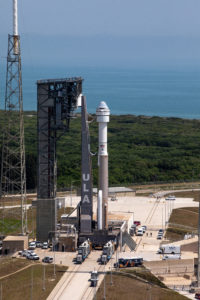
The Boeing CST-100 Starliner is nearing the launch of its Orbital Flight Test-2 (OFT-2) to the International Space Station for NASA’s Commercial Crew Program. The United Launch Alliance (ULA) Atlas V rocket that will lift the vehicle into space is now fueled and configured for stable replenish. Additionally, the pad team has been cleared to re-enter Space Launch Complex-41 for spacecraft closeout operations. Everything remains on target for the 6:54 p.m. ET launch from Cape Canaveral Space Force Base in Florida.
Just prior to cryogenic propellant loading, Starliner began receiving a dry atmosphere through the launch vehicle’s gaseous nitrogen purge system. The service module oxidizer isolation valves have completed their final cycling prior to launch. The valves have been cycled seven times since propellant loading at the factory. As part of standard prelaunch ops, at about L-30 minutes, they’ll be opened for flight.
The Atlas V RD-180 main engine and two solid rocket boosters will ignite to generate more than a million and half pounds of thrust to lift the rocket away from the pad. The RD-180 main engine burns 48,800 gallons of liquid oxygen and 25,000 gallons of RP-1 fuel, a highly refined kerosene, to generate 860,300 pounds of thrust.
The Centaur is powered by two RL10A-4-2 engines that consume 12,300 gallons of liquid hydrogen and 4,150 gallons of liquid oxygen to generate a combined 44,600 pounds of thrust to shape the desired trajectory for Starliner. During the flight, Atlas V will accelerate Starliner to 17,475 mph.
The powered flight of Atlas V to launch Starliner’s OFT-2 lasts about 11 minutes and 55 seconds. The first stage of flight will last about 4 minutes and 30 seconds. The single burn of the Centaur lasts about 7 minutes and 10 seconds.
